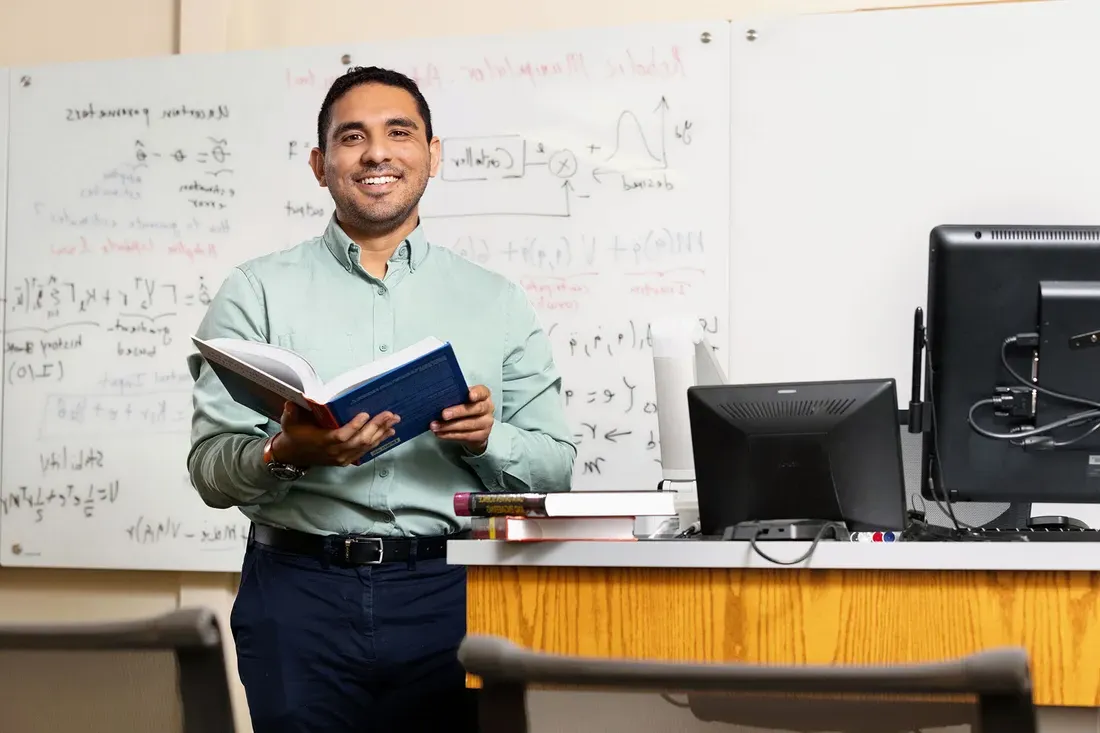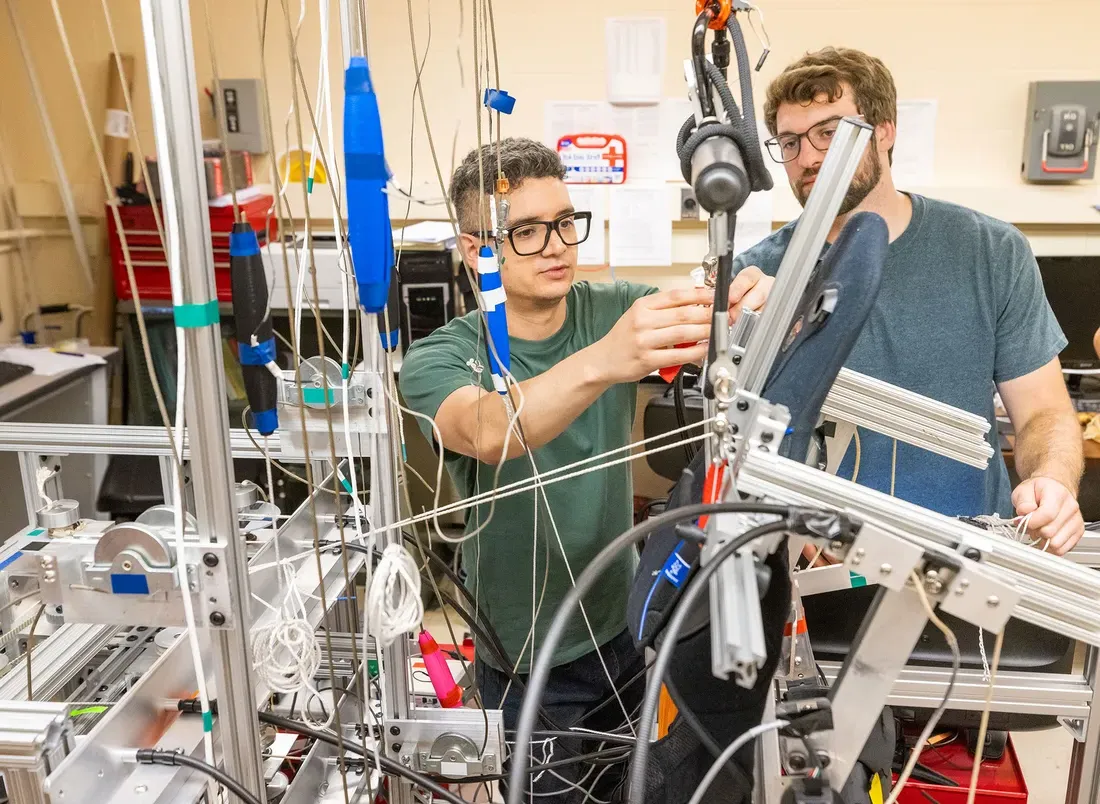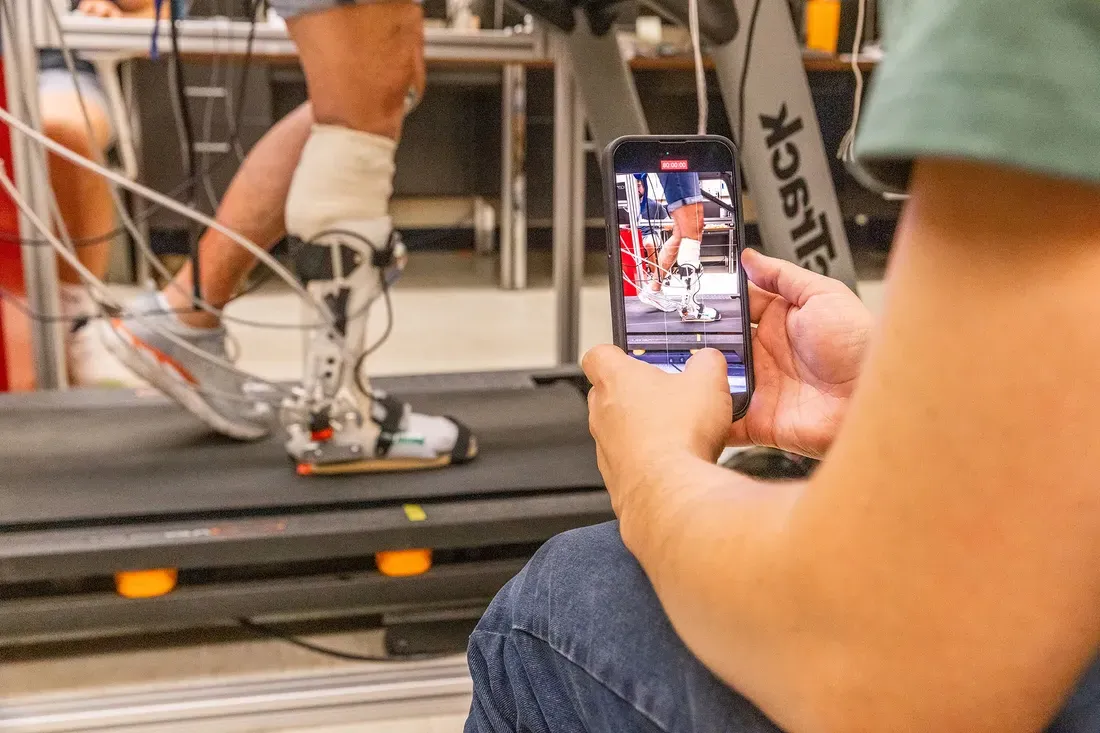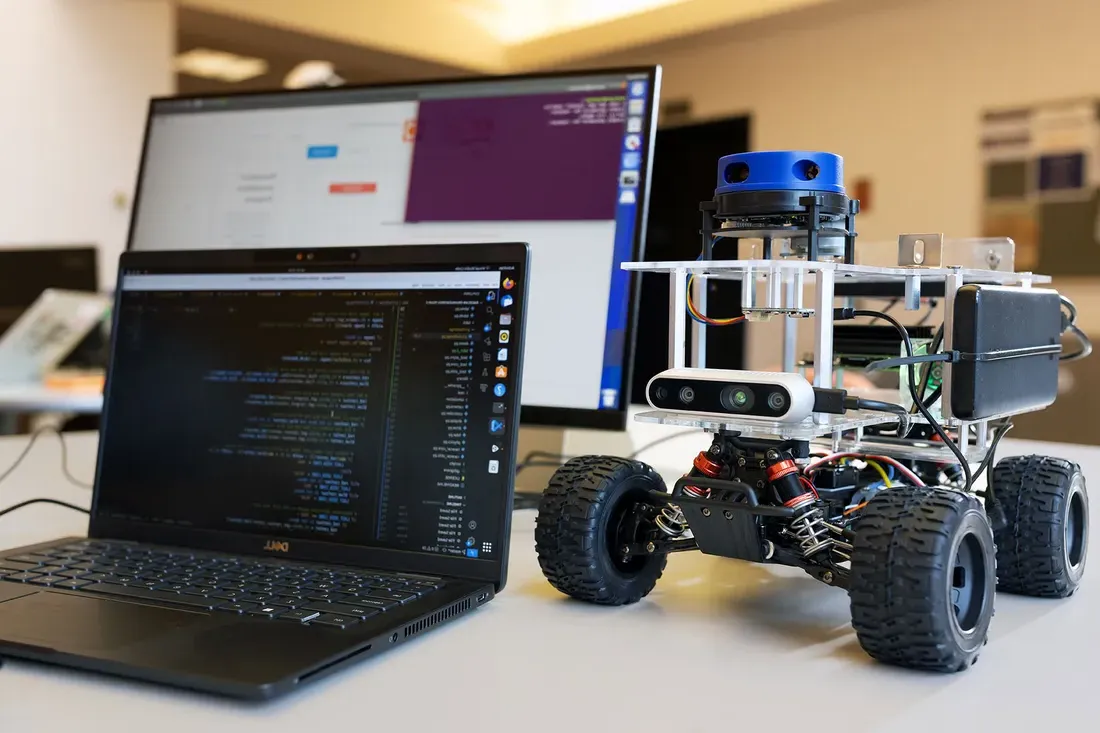
Stroke survivor Patty Jowett wears a lower-limb exoskeleton in Syracuse University's Bionics, Systems and Controls (BSC) Lab. “I have a smile on my face every time I leave here," she says.
In 2014, Patty Jowett suffered a stroke that briefly rendered the left side of her body immobile. “My shoulder, arm and fingers are still weak, but I’m doing better,” admits the 67-year-old Syracuse native. “Through physical and occupational therapy, I’m getting my life back.”
So when Jowett heard that Victor Duenas, a professor in Syracuse University’s College of Engineering and Computer Science, was looking for test subjects for his Bionics, Systems and Controls (BSC) Lab, she jumped at the opportunity. Days later, Jowett found herself on campus draped in cables and lead wires, pedaling a stationary recumbent motorized cycle.
On the surface, there’s nothing unusual about this and Duenas’ other contraptions, which include a compressive walking boot and a wearable lower-limb exoskeleton, each connected to a patient monitoring system. But it’s the proprietary algorithms, code and programming running the devices—not the devices, themselves—that are noteworthy.
“I have a big smile on my face every time I leave Victor’s lab,” says Jowett, a vocational rehabilitation counselor. “As a stroke survivor and advocate, I feel like he’s on the verge of something big.”
Bringing New Power to Programming

Professor Victor Duenas is a self-described "experimentalist" who oversees the BSC Lab.
Duenas often jokes about the BSC Lab being a “five-year, overnight success story.” Housed in the basement of Link Hall, it grew out his doctoral work at the University of Florida and became official with his arrival at Syracuse in 2018. Since then, the lab has borne witness to a wide range of robotic tools and equipment while bringing new power to programming.
“I focus on the design, analysis and experimental implementation of control systems for human-robot interactions,” says Duenas, a Mexican-born mechanical engineer. His fluency in control theory, which explores how electrical and mechanical systems work together to achieve a desired result, largely accounts for his success as an experimentalist.
Duenas’ first Ph.D. student, Chen-Hao Chang G’22, helped design and manufacture the lab’s stationary cycle and exoskeleton. He also assisted with research projects with the Syracuse VA Medical Center and The Medical University of South Carolina.
A central theme of Chang’s work was functional electrical stimulation (FES), which applies small electrical charges to weakened or paralyzed muscles. FES, he explains, is particularly effective in treating foot drop, a side effect of stroke. “A big challenge was dealing with movement unpredictability and muscle fatigue, which affect the way you develop and implement a control system,” says Chang, a senior control engineer at the chipmaking juggernaut ASML. “Still, Professor Duenas always listened to my feedback and trusted me make the necessary adjustments.”
Bridging Theory and Practice

Jonathan Casas G’23 (right) has parlayed his University training into a research position in Germany.
Jonathan Casas G’23 also figures prominently in the lab’s evolution, having worked almost exclusively on the exoskeleton. He refers to it as a “bionic robot” for gait function. “It promotes self-care and self-esteem,” says the newly appointed research associate at the Technical University of Dresden in Germany. “Of all our rehabilitation devices, this one probably has the most far-reaching societal implications.”
Casas recalls how Duenas encouraged him to “close the loop between theory and practice,” using mathematical modeling and computer simulations to inform the exoskeleton’s functionality. “We eventually came up with software that would let us design almost any kind of controller we wanted,” says Casas, regarding the robot’s so-called brain. “I learned technical skills and strategies that will benefit me for years to come.”
Other researchers echo these sentiments, noting Duenas’ proclivity for having graduate students mentor undergraduates, who, in turn, assist the occasional high school intern.
One such undergraduate is Jade Carter ’24, who studies robotic devices called powered ankle-foot orthoses (PAFOs). A senior majoring in biomedical engineering, she says that such boot-like devices are invaluable to stroke patients because their control systems can read and interact with the external environment. Thus, PAFOs can improve walking ability, gait speed and balance.
“I’ve always been interested in biomechanics, but thanks to Dr. Duenas, I now have a twin passion for rehabilitation engineering and gait training,” Carter says.
Nicholas Rubino G’24 also studies PAFOs and is part of a team of students developing the computer architecture necessary to run such experiments. “There’s lots of trouble shooting with rehabilitation robotics,” notes the aspiring Ph.D. student. “Dr. Duenas reminds me that every problem needs to be addressed in context of a complete, robust system.”
Putting Their Best Foot Forward

The BSC Lab helps students close the loop between theory and practice.
As an undergraduate, Eleanor Lawler ’22, G’24 distinguished herself as a cross country and track and field champion. Today, she’s racing the clock to design PAFOs that ensure “robustness and comfort across stroke victims.” “My research into healthy physical locomotion hasn’t just made me a better runner. It’s also made me sympathetic toward patients with long-term impairment,” says the master’s student in mechanical and aerospace engineering.
Lawler collaborates with students like Evan Tulsky ’24, whose mathematical acumen has earned him a high-profile conference paper. “Everyone pushes me hard, but that’s how we get results,” says Tulsky, a senior majoring in mechanical engineering.
Duenas underscores the importance of dignity and respect in the classroom. And the lab. “We create devices that are safe and empowering,” he says smiling. “I want my students—and people like Patty Jowett—to put their best foot forward.”


